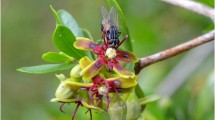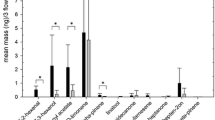Abstract
In order to define the part of olfactory cues in the selective behavior of honeybees, observation on their foraging behavior was carried out on various sunflower genotypes in parallel with chemical analysis of aromatic extracts of the genotypes. Foragers show a preference for the early stages of flowering and, when they are given a choice between couples of parental lines of two commercial hybrids, Marianne and Mirasol, they are randomly distributed on Mirasol parents, but they prefer the female line of Marianne. The comparison of relative proportions of compounds among aromagrams obtained from head space trapping from the two couples of genotypes, reveals (1) a phenological stage effect for 17 compounds among 144 indexed compounds for Marianne lines and for 18 among 136 indexed compounds of Mirasol lines; most of these compounds exhibit higher relative proportions in the early flowering stages, which is related to plant attractiveness towards honeybees; (2) a sex effect for 33 compounds among 144 for Marianne lines and for 14 compounds among 136 for Mirasol lines; further semiquantitative analyses reveal a sex effect for only eight compounds of 134 for Marianne lines and 20 compounds of 250 for Mirasol lines, which represents less than 10% of the indexed compounds. These discriminatory compounds were partly identified by coupled GC-MS. Possible relations between such phenological and genotypical volatile fluctuations and forager attraction are discussed.
Similar content being viewed by others
References
Bachacou, J., Masson, J.P., andMillier, C. 1981. Manuel de la programmathèque statistique AMANCE 81. Champenoux, INRA. pp. 517.
Benedek, P., andManninger, S. 1972. Pollinating insects of sunflower and the activity of honeybees on the crop.Novenytermeles 21(2):145–157.
Delaude, A., Tasei, J.N., andRollier, M. 1979. Pollinator insects of sunflower (Helianthus annuus L.) in France, pp. 29–40,Proceedings IV International Symposium Pollination, Maryland Agricultural Experiment Station, College Park, Maryland, 1978.
Drane, D., McPherson, R., andWhite, K. 1982. Pollination studies in hybrid sunflower seed production, pp. 25–99,in Proceedings X International Sunflower Conference, Australia.
Eckert, W.R., Zeman, A., andMoser, R. 1973. Occurrence of terpene hydrocarbons in sunflower oil.Fette, Seifen, Anstrichm. 75(8):475–478.
Etievant, P.X., andBayonove, C.L. 1983. Aroma components of pomaces and wine from the varity Muscat de Frontignan.J. Sci. Food Agric. 34:393–403.
Etievant, P.X., Azar, M., Pham-Delegue, M.H., andMasson, C. 1984. Isolation and identification of volatile constituents of sunflower (Helianthus annuus L.)J. Agric. Food Chem. 32(3):503–509.
Flath, R.A., Mon, T.R., andRogers, C.E. 1985. Volatile constituents of oilseed sunflower heads (Helianthus annuus L.), Semiochemistry: Flavors and Pheromones.in T.E. Acree and D. M. Soderlund, (eds.). Walter De Gruyte and Co. Berlin, pp. 265–272.
Fonta, C., Pham-Delegue, M.H., Marilleau, R., andMasson, C. 1985. Rôle des nectars de tournesol dans le comportement des insectes pollinisateurs et analyse qualitative et quantitative des éléments glucidiques de ces sécrétions.Acta Oecolog. Oecol. Applic. 6(2):175–186.
Free, J.B., andSimpson, J. 1964. The pollination requirements on sunflowers.Emp. J. Exp. Agric. 32(128):340–342.
Freund, D.E., andFurgala, B. 1982. Effect of pollination by insects on the seed set and yield of ten oilseed sunflower cultivars.Am. Bee J. 122:648–652.
Frisch, K. von. 1967. The Dance Language and Orientation of Bees. The Belknap Press of Harvard University Press, Cambridge, Massachusetts. 566 pp.
Gershenzon, J., Ohno, N., andMabry, T.J. 1981. The terpenoid chemistry of sunflowers (Helianthus).Rev. Latinoam. Quim. 12(2):53–61.
Gracian, J., andArevalo, G., 1980. Determination of waxes in sunflower oil.Grasas Aceites 31(6):403–410.
Hefendehl, F.W., andMurray, M.J. 1976. Genetic aspects of the biosynthesis of natural odors.Lloydia 39(1):39–52.
Homberg, E.E., andSchiller, H.P.K. 1973. Neue Sterine inHelianthus annuus.Phytochemistry 12:1767–1773.
Iriuchijima, S., Kuyama, S., Takahashi, N., andTamura, S. 1966. Structure of heliangine, a novel ten-membered sesquiterpene Lactone.Agric. Biol. Chem. 30:511–512.
Karawya, M.S., Khafagy, S.M., Hifnawy, M.S., Farrag, N.M. 1980. SunflowerHelianthus annuus sterols carbohydrates volatile oil and analysis of cake.Egypt. J. Pharm. Sci. 21(1–2):83–92.
Kasprzyk, Z., andJaniszowska, W. 1971. Triterpenic alcohols from the shoats ofHelianthus annuus.Phytochemistry 10:1946–1947.
Koltermann, R. 1969. Lern-und Vergessensprozesse bei der Honigbiene-aufgezeigt Anhand von Duftdressuren.Z. Vergl. Physiol. 63(3):310–334.
Leclercq, P. 1969. Une stérilité mâle cytoplasmique chez le tournesol.Ann. Amélior. Plant. 19(2):99–106.
Manning, A., 1957. Some evolutionary aspects of the flower constancy of bees.Proc. R. Phys. Soc. Edinb. 25(3):67–71.
Masson, C. 1983. Rôle des médiateurs chimiques d'origine animale et végétale dans la pollinisation. pp. 23–37,in C.R. 5è Symposium Internationale Pollinisation, INRA Ed.
Morimoto, H., Sanno, Y., andOshio, H. 1966. Chemical studies on heliangine, a new sesquiterpene lactone isolated from the leaves ofHelianthus tuberosus Tetrahedron 22:3173–3179.
Ohno, N., andMabry, T.J. 1979. Germacranolides inHelianthus mollis.Phytochemistry 18:1003–1006.
Ortega, A., Romo de Vivar, A., Diaz, E., andRomo, J. 1970. Determinacion de las estructuras de la calaxina y de la ciliarina, nuevos germacranolidos furanonicos.Rev. Latino Amer. Quim. 1:81–85.
Parker, F.D. 1981. Sunflower pollination: Abundance, diversity and seasonality of bees on male-sterile and male-fertile cultivars.Environ. Entomol. 10:1012–1017.
Pham-Delegue, M.H., Masson, C., Etievant, P., andAzar, M. 1986. Selective olfactory choices of the Honeybee among sunflower aromas: A study by combined olfactory conditioning and chemical analysis.J. Chem. Ecol. 12(3):781–793.
Popescu, H. 1979.Helianthus annuus L.—a source of volatile oil.Farmacia 27(4):243–247.
Popescu, H. 1982. Les fleurs deHelianthus annuus L., possible source d'essence à menthol.Clujul Med. 55(3):199–203.
Popescu, H. Fagarasan, E., andPop, L. 1979. Physiochemical investigations on a volatile oil recently isolated from sunflowers (Helianthus annuus L).Clujul Med. 52(2):171–176.
Putt, E.D. 1940. Observations on morphological characters and flowering processes in the sunflower (Helianthus annuus L.).Sci. Agric. 21:167–179.
Putt, E.D. 1978. History and present world status, pp. 1–29,in J.F. Carter (ed.). Sunflower Science and Technology. American Society of Agronomy, Madison, Wisconsin.
Pyrek, J.S. 1970. New pentacyclic diterpene acid, trychloban-19-doic acid from sunflower.Tetrahedron 26:5029–5032.
Radford, B.J., andRhodes, J.W. 1978. Effect of honeybee activity on the cross pollination of male sterile sunflower.Queensl. J. Agric. Sci. 35:153–157.
Robacker, D.C., Flottum, P.K., Sammataro, D., andErickson, E.H. 1982. Why soybeans attract honey bees.Am. Bee J. 7:481–519.
Robacker, D.C., Flottum, P.K., Sammataro, D., andErickson, E.H. 1983. Effects of climatic and edaphic factors on soybean flowers and on the subsequent attractiveness of the plants to honey bees.Field Crops Res. 6:267–278.
Rudloff, E. von, andUnderhill, E.W. 1965. Gas-liquid chromatography of terpenes—XII: Seasonal variation in the volatile oil fromTanacetum vulgare L.,Phytochemistry 4:11–17.
Shein, S.E., Sargent, S.J., andMiko, J. 1978. An evaluation of differential attractiveness genotypes to honey bees. pp. 216–220,in 9e Conference mondiale sur le tournesol, Torremolinos, Spain.
Simidtchev, T. 1976. Production de pollen et de nectar de tournesol. La flore mellifere, base de l'apiculture, pp. 139–149,in Symposium International Apimondia, Bucharest.
Stipanovic, R.D., O'Brien, D.H., Rogers, C.E., andThompson, T.E. 1979. Diterpenoid acids, (−)-cis-and (−)-trans ozic acid, in wild sunflower,Helianthus occidentalis.J. Agric. Food Chem. 27:458–459.
Tepedino, V.J., andParker, F.D. 1982. Interspecific differences in the relative importance of pollen and nectar to bee species foraging on sunflowers.Environ. Entomol. 11:246–250.
Author information
Authors and Affiliations
Rights and permissions
About this article
Cite this article
Pham-Delegue, M.H., Etievant, P., Guichard, E. et al. Sunflower volatiles involved in honeybee discrimination among genotypes and flowering stages. J Chem Ecol 15, 329–343 (1989). https://doi.org/10.1007/BF02027794
Received:
Accepted:
Issue Date:
DOI: https://doi.org/10.1007/BF02027794




